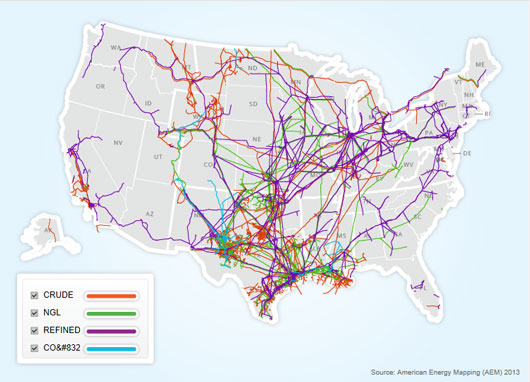Since hurricane season is clearly upon us, I thought this would be an appropriate topic to cover from a preparedness standpoint as well as general understanding of infrastructure.
Please Click to Join my Email List and Get a Great Offer on a Fantastic Book
Where Does My Gasoline Come From?
Depending on how literal we want to be, there are several possible answers to the question, “where does my gas come from?” Some might say that it comes from dead dinosaurs, the ground, or even the pump at the gas station, but none of those focus on the infrastructure that we need to understand to know why we face fuel shortages.
In the United States the large largest portion of our fuel delivery infrastructure is based on pipelines. Thousands of miles of buried and above ground pipelines crisscross the North American continent, especially the more populated areas. Crude oil comes from the oil fields of the nation via pipeline to the refineries in areas such as Texas, Louisiana, and Pennsylvania. At the refineries, crude oil is converted into gasoline, diesel, kerosene, and other petroleum distillates. After the oil is rendered into fuel, It is distributed in multiple ways depending on the destination. Some is delivered by ship or barge, some may be delivered by rail, but a large portion of the gasoline and diesel fuel are delivered to major population areas via pipeline.

All of the purple lines on the map are are refined petroleum. Fuels are pumped up these pipelines in massive amounts and diverted to storage tanks in each major area. Here in Northern Alabama we have a major fuel distribution center in Birmingham. From the multiple loading facilities and tanks adjacent to the pipeline, trucks run constantly to supply the gas stations and truck stops of the area. This illustration leads us into the next part of the post.
What Causes Fuel Shortages?
By tracing the lines on the map above you can see that there is only one major pipeline feeding refined petroleum products from the Gulf of Mexico area refineries up the East Coast. Now, Imagine that pipeline being broken at any point along the way, or imagine it’s not being fed anymore at the source. Hopefully it is starting to make a lot more sense why we have fuel shortages in disasters.
When Hurricane Katrina crashed into the coasts of Alabama, Mississippi, Louisiana, and Texas, in August of 2005 I was self employed in the towing business. Fuel scarcity reached an alarming point that drove prices for diesel fuel up to nearly $5 per gallon at times which still didn’t guarantee that there would be any available. Not only were the major refineries damaged and without power, what was already in the pipeline headed north and east was held up due to power loss at the many pumping stations along the way. With this system disabled, all of us from central Alabama and north were cut off from fuel supplies even though we had received very little or no damage from the storm. Other fuel shortages are caused by damage to pipelines. While they are well built, it isn’t unheard of for a pipeline to fail and need to be repaired. Sometimes trucks can be used for bridging the gap to the next pumping station , however, they can’t move the fuel nearly as fast as the pipeline does.
We can see from these few examples just how easy it is to lose a fuel supply for short to extended periods with little recourse other than truck or rail delivery. This is why planning and preparing for fuel shortages is a priority, however our safe storage capacity is limited so it is crucial to be aware of a potential shortage as early as possible. Click on the picture below for storage cans:
How Can I Tell if There Will be A Fuel Shortage?
While there is no guarantee that you we will be able to sense a shortage and make truly long term plans, we can use cues that are found in the news on a daily basis. If we maintain the prepper mentality, we already keep our vehicles fueled up to no less than half a tank. You can read more about vehicle prepping here: https://nickspreparedness.com/2020/07/21/how-to-prepare-for-survival-in-your-car/
Beyond the basics I posted in the above link, we can sense the potential of a fuel shortage based on several news events. One of the most notable is occurring as I write this, a hurricane. Any major storm that impacts an area can effect fuel delivery. This is especially true when the storms hit places around the Gulf of Mexico where a large number of the nations oil fields and refineries are. If you see seriously bad weather warnings for the Gulf Coast, consider staying topped off. Another sign of impending fuel shortages is military action or political tension, especially in the Middle East. Much like the run on toilet paper when the Coronavirus hit the headlines and the panic started, many will speculate that there will be a run on fuel and create a false shortage. Carefully preparing before hand keeps you out of the panic buying crowd and also reduces the strain on the supply by being one less person waiting in line to fill up everything they have to the brim with gasoline.
Not everyone can store extra fuel for various reasons, but if you can safely do so, try to have enough on hand to get you several hundred miles if needed. Also remember to rotate that fuel out just like you would your food. Number your gas cans and pour one per week into your car or use it up mowing grass or in a recreational vehicle. Refill it and move to the next number in line for the next week. Also consider using fuel treatments for keeping your gasoline fresh now that ethanol is usually added and presents long term storage problems. Here is a helpful product:





